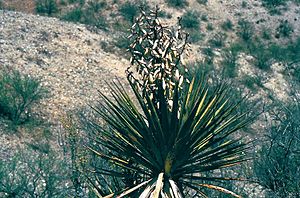Sahualiqui facts for kids
Quick facts for kids Sahualiqui |
|
|---|---|
 |
|
| Conservation status | |
| Scientific classification |
The Sahualiqui (scientific name: Yucca grandiflora) is a special kind of plant that belongs to the Asparagaceae family. It was first described by a scientist named H.S. Gentry. This plant is native to a mountain range called the Sierra Madre Occidental in Mexico. You can find it growing in the states of Chihuahua and Sonora.
People also call this plant the Large-flowered Yucca because of its big flowers. The Pima Bajo are a group of people who live in the area where this plant grows. They sometimes eat the fruits of the Sahualiqui when they are still young and not fully ripe. Even though this plant can be found in many places, there aren't a lot of them growing close together.
What is the Sahualiqui?
The Sahualiqui is a type of Yucca plant. Yuccas are known for their tough, spiky leaves that often grow in a rosette shape, like a big star. They are usually found in dry, sunny places. The Sahualiqui is special because of its "grandiflora" name, which means "large flower." This tells us it has impressive blooms!
Where the Sahualiqui Grows
This unique Yucca plant calls the Sierra Madre Occidental mountains its home. This mountain range stretches through parts of Mexico, including the states of Chihuahua and Sonora. These areas often have a dry climate, which is perfect for Yucca plants. Even though the Sahualiqui can be found across a wide area in these states, it doesn't grow in big, dense groups. Instead, you might find individual plants spread out, making them a bit rare to spot in any one place.
How People Use the Sahualiqui
For many years, the Pima Bajo have lived in the regions where the Sahualiqui grows. They have learned to use the plants around them for food and other needs. One interesting way they use the Sahualiqui is by eating its fruits. They pick the fruits when they are still young and not fully ripe. This shows how people can live in harmony with nature and use what the land provides.


